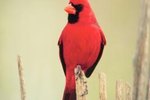
A female budgie will make a nest using whatever happens to be in her cage, such as shredded paper or her own feathers. A nice wooden, nesting box however, will give her and the babies the privacy and protection they need during the brood. The budgie will choose her own spot within the box to use as the nest so give her plenty of room while keeping the space small enough to make her feel secure.
Step 1
Choose thin wooden panels to make the nest box as cardboard will be too flimsy and the birds will chew on it. Using a circular saw, cut the four side panels to a measurement of 12 by 14 inches. Cut the top and bottom panels to a measurement of 14 by 14 inches.
Step 2
Use a rotary cutting tool to cut a hole measuring 3 inches in circumference through the bottom portion of the back panel of the box. This is the entrance hole. Make sure the hole in the nest box lines up with the open cage door and that the bird can move easily through the hole.
Step 3
Nail all of the side pieces together, making sure that the points of the nails don't come through to the inside. Nail the bottom piece onto the box and screw hinges on the edge of the top piece of wood and into one side piece. This is the removable top.
Step 4
Drill two holes into the top of the back panel of the left side of the box. Drill another two holes on the right side. Line up the holes in the back of the box with the horizontal wires of the cage and using two 8-inch long plastic cable ties, tie the nest box tightly to the front of the budgie cage.
Step 5
Use clean straw as bedding for the bottom of the nest box. This will be used by the budgie as nesting material. Put it in through the removable top and secure the lid once again. Hay or sawdust also can be used in the absence of straw.
References
Tips
- If a tighter bond to the cage is desired, drill more holes into the back of the nest box and tie it with more cable ties.
Warnings
- Don't use shredded paper as nesting material as it can cause the young chicks to develop splayed legs, which is crippling.
Photo Credits
-
BananaStock/BananaStock/Getty Images




